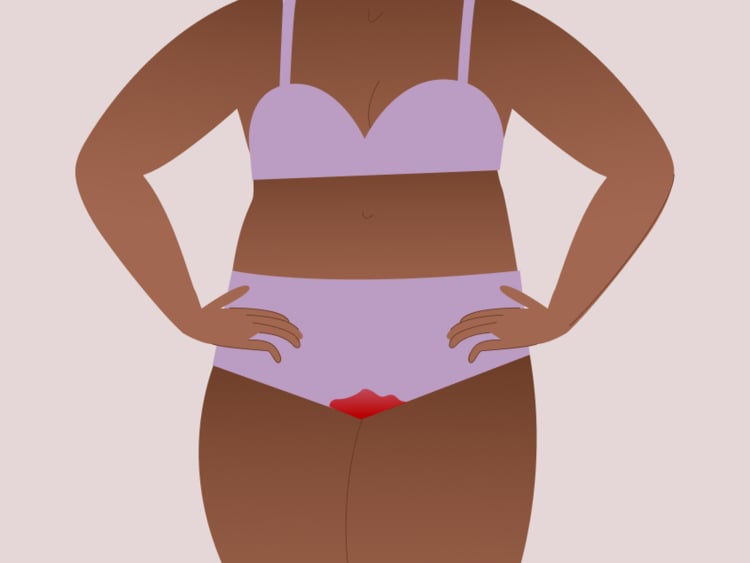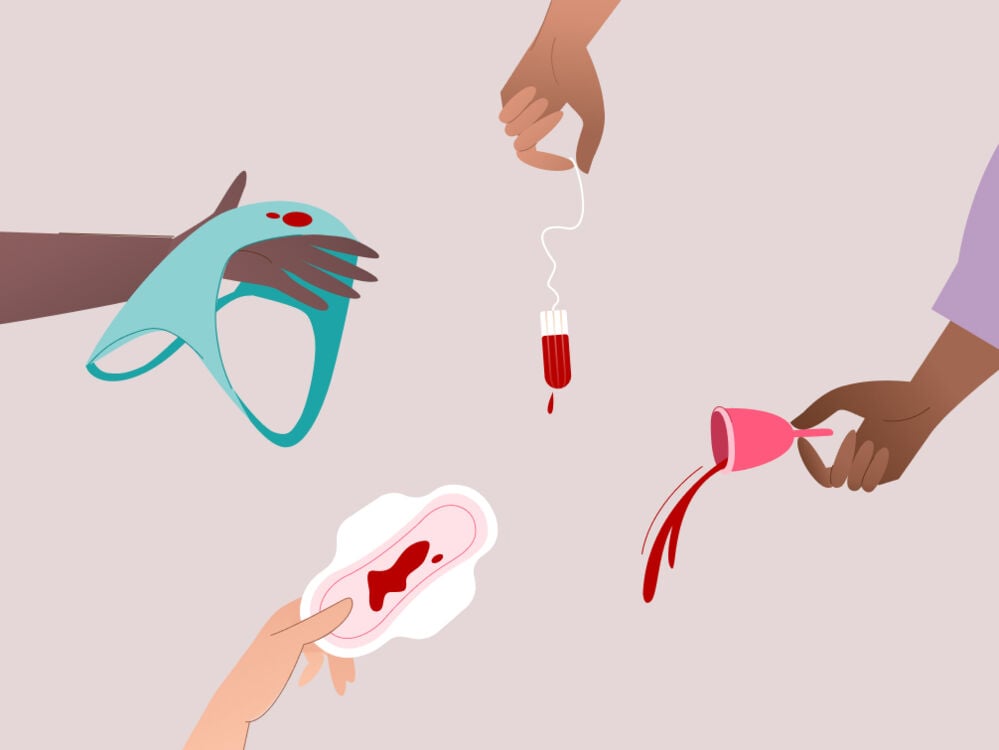Free bleeding, or choosing not to use period products, is a centuries-old practice. Here, two experts explain if it’s safe and sanitary.
-
Tracking cycle
-
Getting pregnant
-
Pregnancy
-
Help Center
-
Flo for Partners
-
Anonymous Mode
-
Flo app reviews
-
Flo Premium New
-
Secret Chats New
-
Symptom Checker New
-
Your cycle
-
Health 360°
-
Getting pregnant
-
Pregnancy
-
Being a mom
-
LGBTQ+
-
Quizzes
-
Ovulation calculator
-
hCG calculator
-
Pregnancy test calculator
-
Menstrual cycle calculator
-
Period calculator
-
Implantation calculator
-
Pregnancy weeks to months calculator
-
Pregnancy due date calculator
-
IVF and FET due date calculator
-
Due date calculator by ultrasound
-
Medical Affairs
-
Science & Research
-
Pass It On Project New
-
Privacy Portal
-
Press Center
-
Flo Accuracy
-
Careers
-
Contact Us
What is free bleeding? All about free bleeding movement


Every piece of content at Flo Health adheres to the highest editorial standards for language, style, and medical accuracy. To learn what we do to deliver the best health and lifestyle insights to you, check out our content review principles.
The history of free bleeding goes back centuries, if not for as long as humankind has existed.
For some women and people who menstruate, free bleeding or choosing not to use period products is a personal choice. It’s a powerful way of protesting against period-shaming and costly menstrual products that millions of people across the world still don’t have access to. For other people, it’s a more environmentally sustainable way to manage their period.
Your experience with your period can be deeply personal. “So many people are ashamed or embarrassed when they stain their clothing during a period — free bleeding is trying to destigmatize this,” explains Dr. Sara Twogood, an obstetrician-gynecologist (OB-GYN) who sits on Flo’s medical board.
Read on for an expert guide on free bleeding with the help of two OB-GYNs, covering the history of the modern movement as well as whether it’s safe and sanitary.
What is free bleeding?
Free bleeding is when someone menstruates without using period products such as tampons or pads to collect or absorb the blood. You might feel a bit daunted initially — but for some, free bleeding is an incredibly liberating experience.
“Some people choose to free bleed as part of a movement to normalize menstruation and remove its associated stigma,” explains Dr. Jenna Beckham, OB-GYN, clinical assistant professor and Flo medical board member. But with period poverty rife across the globe, others “free bleed not by choice but because of lack of access to menstrual products,” she adds.
Period poverty is defined as having a lack of access to period products due to financial constraints. The World Bank estimates that at least 500 million women and people who have periods around the world don’t always have access to the products, support, and facilities they need. Over 14% of college-aged women in the US have experienced period poverty in the last year, and 10% experience this monthly.
Amazingly, some people have used free bleeding to highlight these inequalities. Take the runner Kiran Gandhi who, in 2015, ran the London Marathon while free bleeding into her leggings. In her words, she wanted to “draw light to my sisters who don’t have access to tampons and, despite cramping and pain, hide it away like it doesn’t exist.”
Dr. Beckham also points out that some who free bleed “may be considering the environmental impact of disposable menstrual products” or might choose to do so because they find using tampons or pads uncomfortable. If free bleeding doesn’t feel like quite your thing, but you do want a more sustainable alternative, there are plenty of reusable options available, like period pants (more about those below).
Take a quiz
Find out what you can do with our Health Assistant
Free bleeding: The history of the free bleeding movement
Early records of periods and free bleeding are limited. Still, what we do have goes back thousands of years. The ancient Roman historian Pliny the Elder wrote of the “marvelous powers” of menstruating women, going as far as to say that they could rid fields of wheat of their insects — simply by walking through them naked.
It’s believed that the modern free bleeding “movement” began in the United States in the 1970s, with the emergence of menstrual activism. This came during the era of the toxic shock syndrome epidemic: a rare but potentially fatal condition that can happen if a tampon is left in too long. In 1980 alone, 38 women reportedly died in America from period-related toxic shock. (FYI: tampons should only be left in for a maximum of 8 hours).
Feminists of this time also questioned why they were being shamed for having periods. Dr. Twogood explains how, for these activists, free bleeding was about “revolting against the idea that menstrual bleeding is something to be ashamed of, that it’s gross or unsightly or something that should be hidden.”
More recently, the movement has been linked to motivations such as fighting menstruation stigma, challenging the costs of menstrual products, and advocating for visibility for trans males and non-binary folks.
Period-shaming is rife across the globe today. One peer-reviewed study found that in far-western Nepal, women and girls are made to isolate themselves in livestock sheds — and forbidden to touch other people or objects — during their menstrual cycle. In India, periods are often considered a taboo subject.
What’s more, a study of over 1,000 students in the US found that 76% say there is a negative association that periods are gross and unsanitary, and 65% agree that society teaches people to be ashamed of their periods.
Dr. Beckham agrees that fighting the stigma against periods is a driving factor behind free bleeding today — plus raising awareness of those from marginalized groups, like some transgender and non-binary people, who also have periods.
“More recently, the movement has been linked to motivations such as fighting menstruation stigma, challenging the costs of menstrual products, and advocating for visibility for trans males and non-binary folks who also menstruate,” adds Dr. Beckham.
Free bleeding: Is it unsanitary?
So, if free bleeding sounds like something that could be for you, your next question is probably whether it’s safe and hygienic to do.
Generally, free bleeding is deemed safe for the person doing it, though there are some things to consider when it comes to those around you. That’s because period blood can carry bloodborne viruses, like HIV, Hepatitis C, or Hepatitis B, which can survive outside of the body for days or even weeks.
“A good rule of thumb is to not intentionally or unintentionally expose bodily fluid to another person without their consent, [and] that includes period blood,” advises Twogood.
Assess each potential free bleeding situation as it comes. When would you like to free bleed? Do you plan on doing it all the time or alongside using period products? Free bleeding at home initially may help you understand how much blood to expect and on which days your cycle is heaviest.

Tips on how to try free bleeding
The empowering aspect of the free bleeding movement might sound appealing to you, but the reality is that free bleeding can involve a lot of laundry. However, there are plenty of options out there that may ease this.
Some women and people who menstruate choose to free bleed into their clothes. You might opt to wear your normal underwear — with some people choosing to wear lighter colors deliberately. Another top tip: Put a towel down on the sofa or your bed when sitting or lying down to catch any leaks.
You might also choose to free bleed while wearing period underwear. While designs differ slightly, the idea is that the microfibers in the underwear catch and absorb your period blood to keep you feeling dry and prevent any leaks.
Dr. Beckham says, “some [people] may use period underwear which often incorporates some antimicrobial component” deterring bacteria from growing.
You shouldn’t wear period underwear for longer than 12 hours, and you can either wash them by hand (just make sure that the water runs clear and there’s no more blood left in the fabric) or in the washing machine on a cold delicate cycle. Check the label before washing your period underwear for the first time.
Free bleeding: The takeaway
For those who choose to do so, free bleeding is a powerful tool for spotlighting period-shaming that continues around the world today — and the plight of millions of people who do not have access to period products.
“The stigma may become less by discussing the topic out loud across all genders and avoiding shaming words and phrases when discussing periods,” concludes Dr. Twogood.
How you manage your period can be deeply personal to you. But if free bleeding is something you’d like to try, then it’s safe and hygienic, has a long history, and you can do it however and whenever you want to.


Hey, I'm Anique
I started using Flo app to track my period and ovulation because we wanted to have a baby.


The Flo app helped me learn about my body and spot ovulation signs during our conception journey.


I vividly
remember the day
that we switched
Flo into
Pregnancy Mode — it was
such a special
moment.
Real stories, real results
Learn how the Flo app became an amazing cheerleader for us on our conception journey.
References
Amatya, Prabisha, et al. “Practice and Lived Experience of Menstrual Exiles (Chhaupadi) among Adolescent Girls in Far-Western Nepal.” PloS One, vol. 13, no. 12, Dec. 2018, p. E0208260. Accessed 9 Aug. 2022.
Bobel, Chris. New Blood: Third-Wave Feminism and the Politics of Menstruation. Rutgers University Press, 2010. Accessed 9 Aug. 2022.
Cardoso, Lauren F., et al. “Period Poverty and Mental Health Implications among College-Aged Women in the United States.” BMC Women’s Health, vol. 21, no. 1, Jan. 2021, p. 14. Accessed 9 Aug. 2022.
“Hepatitis B FAQs.” Centers for Disease Control and Prevention, 31 Mar. 2022, www.cdc.gov/hepatitis/hbv/bfaq.htm. Accessed 9 Aug. 2022.
Chen, Guangzhen. “Menstrual Hygiene Management Enables Women and Girls to Reach Their Full Potential.” World Bank Group, 7 June 2018, www.worldbank.org/en/news/feature/2018/05/25/menstrual-hygiene-management. Accessed 9 Aug. 2022.
Gandhi, Kiran. “Going with the Flow.” Medium Endless, 20 July 2015, medium.com/endless/going-with-the-flow-blood-sisterhood-at-the-london-marathon-f719b98713e7. Accessed 9 Aug. 2022.
“Historical Perspectives Reduced Incidence of Menstrual Toxic-Shock Syndrome: United States, 1980–1990.” Centers for Disease Control and Prevention, 29 June 1990, www.cdc.gov/mmwr/preview/mmwrhtml/00001651.htm. Accessed 9 Aug. 2022.
“India’s Period Poverty Amidst the Pandemic Exposes State Apathy Towards Women's Issues.” King’s College London. www.kcl.ac.uk/indias-period-poverty-amidst-the-pandemic-exposes-state-apathy-towards-womens-issues. Accessed 9 Aug. 2022.
James, Karmon. “What Is Period Underwear and Does It Work?” Cleveland Clinic, 7 Feb. 2022, health.clevelandclinic.org/does-period-underwear-work/. Accessed 9 Aug. 2022.
Pliny the Elder, The Natural History, BOOK XXVIII. REMEDIES DERIVED FROM LIVING CREATURES., CHAP. 23.—FACTS CONNECTED WITH THE MENSTRUAL DISCHARGE. www.perseus.tufts.edu/hopper/text?doc=urn:cts:latinLit:phi0978.phi001.perseus-eng1:28.23. Accessed 9 Aug. 2022.
“State of the Period 2021.” Period.org, period.org/uploads/State-of-the-Period-2021.pdf. Accessed 9 Aug. 2022.
“What If I Forget to Remove My Tampon?” National Health Service, www.nhs.uk/common-health-questions/womens-health/what-if-i-forget-to-remove-my-tampon/. Accessed 9 Aug. 2022.




